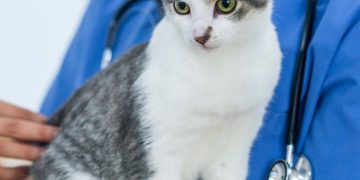All about Cats Eyes – Cats have always been mysterious creatures. They play hard to get, they love to hide, and they’re always up to something. But while we might not know everything about our feline friends (or the things they do in the middle of the night), there are some things you can learn about cat eyes if you just know where to look. In this post, we’ll walk through 10 facts about your cat’s vision that will help you understand them even better than before!
Cat eyes have a third eyelid.
Cats have a third eyelid called the nictitating membrane. This membrane can be seen in cats’ eyes when they are sleeping and helps clean and protect their eyes. The color of this third eyelid is typically pink or red, but some cats may have blue or green membranes instead.
Cats have better night vision than humans.
This is a fact that you might already be aware of, but cats have better night vision than humans. Their eyes are more sensitive to light and can see in dim light or even darkness, which means that they can also see in low-light levels. Cats can also see very bright light, so don’t worry if you ever turn on the kitchen lights while your cat is asleep on top of the fridge!
Your cat’s eyes may change color after they’re born.
If you have ever wondered why your cats eyes are blue, the answer may surprise you. Cats are born with blue eyes, but they don’t always stay that way. In fact, it’s normal for cats’ eye color to change over time. In most cases, kittens and puppies have light blue eyes that gradually turn green or yellow as they age. But albinism can also cause a kitten to be born with brown or pinkish-colored eyes instead of the typical blue hue.
Now you know why cats eyes change color!
Cats can’t see red.
The color red is the first to go in your cats eyes.
Cats can’t see red because they don’t have a certain pigment, called dichromatic vision, which allows them to see colors of both long and short wavelengths. Humans have this pigment, so they can see reds and oranges while cats only see yellows and greens. This is why cats appear to be color-blind when compared with humans—they actually have less detail in their perception of color shades (especially those outside the rainbow). However, there are no studies that show whether or not cats truly perceive “red” as gray rather than its actual hue; it’s possible that we perceive it as gray ourselves because our brains process information differently from animals’.
Your cat communicates to you with her eyes.
Your cats eyes are full of information. They communicate to you and other cats how she feels, what she wants, and even how healthy she is.
Your cat’s pupils dilate when she sees something interesting or frightening. If your stoner kitty is lounging around the house with her eyes half-closed, chances are that means she’s relaxed and content—she probably doesn’t want to play right now. On the other hand, if her pupils are fully dilated (think big black dots on white), that means she’s nervous or excited about something in her environment (or a little bit too high).
Whether it’s through body language or their expressive faces, cats have plenty of ways to let us know what they’re thinking without actually saying a word!
Sometimes cats’ pupils look like vertical slits.
You’ve probably heard that cats’ eyes can dilate and constrict, just like humans’. But did you know that they can do so much more?
Cats have a unique set of eye structures that make them see in the dark. Their eyes have a layer of cells called tapetum lucidum, which reflects light back into the eye, making it possible for them to see better at night. This helps cats hunt at night when prey is most active. In addition to helping them see better in low light, these reflective cells also help protect their retinas from overstimulation by allowing more light through than otherwise would be possible. To add some visual intrigue to your cat’s “I’m bored” face, try shining a flashlight directly into its eyes: You’ll notice how this makes their pupils appear vertical slits rather than round dots!
If a cat’s pupils are dilated, it could mean something is wrong.
A cat’s pupils can dilate for a number of reasons, but it’s important to understand that this is not a normal part of their behavior. If your cat’s pupils are dilated, it could mean a number of things are wrong and you should take them to the vet as soon as possible.
Pupils that appear enlarged or very large in size may indicate an infection or inflammation in your cats eyes. If this leads to pain or discomfort, the pupil will become smaller due to reflexive changes associated with increased light sensitivity from these symptoms (this is why we squint when we see something bright).
It’s important to remember that while there is no correlation between the size of your cat’s eye and its health, if they are experiencing any discomfort due to their dilated pupils then they need medical attention right away!
A cat can see in almost total darkness.
Have you ever wondered how your cat can see in the dark? The answer is simple: a reflective layer behind their retina that reflects light back into the eye. This structure is called a “tapetum lucidum,” and it works like a mirror. If you shine a flashlight on your cat at night, you might notice that they appear to be glowing under the light—that’s because they are reflecting what little light there is in order to get more illumination out of it. Since cats have this ability (and most animals do), it’s not unusual for owners to see glowing eyes coming from an animal outside at night.
This special adaptation allows cats to see well even when there isn’t much light around them due to evolutionary adaptations over millions of years!
Cats don’t need glasses or contact lenses, but some do get cataracts and astigmatism and need surgery to correct the problem.
As with humans, cataracts and astigmatism are common eye problems for older cats. Cataracts cause cloudiness in the lens, which can lead to blindness if not corrected. In some cases, surgery is the best option for correcting a cat’s vision.
Cats can judge distances very accurately.
Another thing to know about cats eyes is that they have a good sense of distance. They can judge distances better than humans, and they’re better at it in low light. In fact, scientists believe cats may be the only species of animal that can accurately judge distance in low light conditions (dogs are among the other animals who are thought to have this ability).
Furthermore, cats also seem to be able to make out objects even when those objects are really far away. While human vision is about 20/20 but drops off considerably at distances greater than 30 feet (9 meters), cat vision is less like a camera lens and more like binoculars: their eyes each contain approximately 130 million photoreceptors (cones), compared with around 6 million cones in humans — which means cats have much higher visual acuity than we do!
Even though it’s true that dogs do see farther than us and horses can see farther still thanks to their large retinas packed densely with photoreceptors, no one knows for sure what kind of “vision” these animals experience when looking at distant objects because we don’t really know how any animal perceives its environment beyond what little evidence we might gather from behavioral studies; but one thing’s for sure: If you’ve ever wondered why your cat always seems so curious about things happening outside his or her home base — even late at night when there aren’t usually any people or other animals around — now you know why!
You don’t need to be a vet to know how your cat sees the world!
Some things about cats eyes, however, are easy to understand. They’re more sensitive to light than human eyes and can see in the dark better than people do.
Cats can judge distances better than we can and can see in almost total darkness. If you’ve ever wondered how your cat is able to find his way around at night or in dimly lit areas of your home, this is one of the reasons why!
Read More:
Conclusion
Cats are fascinating animals, and their eyes are one of the most interesting features. The way they view the world is very different from ours, but they still manage to get around just fine! If you want to learn more about how your cat sees the world, check out this article by PetMD on How Cats See the World. They’ve got some great information about cats’ vision and some fun facts that will help make petting time even better (because let’s face it: who doesn’t love petting their favorite feline friend?).

























